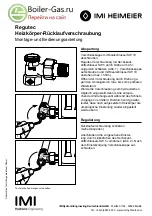
TFTN 085-199 Installation and Operation Manual
45
Air Removal
–
The boiler and system plumbing layout must be configured to promote the removal of air from the water. Air
vents and bleeders must be strategically placed throughout the system to aid in purging the air from the system during
commissioning of the boiler. The system must also employ the use of a strategically located air removal device, such as
an air scoop or micro-bubbler, designed to remove the air from the water as it flows through the system.
Follow the installation instructions included with the air removal device when placing it in the
system; air removal devices generally work better when placed higher in the system. Always
locate air removal devices in areas of the system that have a guaranteed positive pressure, e.g.,
close to the water make-up and expansion tank.
TFTN boilers are supplied with an Auto Air Vent to aid in the purging of air from the boiler during
the initial fill. Place this devise in the location indicated in Figure 10-1.
Expansion Tank
–
The expansion tank must be sized in accordance with the water volume of the system as well as the firing
rate of the appliance. It is important to locate the expansion tank, and make-up water fill, on the inlet side of any
circulator in the system, as doing so will guarantee the lowest pressure in the system will be at least equal to the tank
and make-up water pressure. See examples in Figures 10-3 through 10-8.
Ensure the expansion tank cannot become isolated from the boiler anytime the system is
operating. Failure to follow these instructions may result in discharge of the Pressure Relief Valve
may result in property damage or personal injury.
The installation of flow checks, motorized valves, or other shutoff devices (other than for the
purpose of servicing) are not permitted between the location of the "Closely Spaced Tees" and the
expansion tank; see Figures 10-3 through 10-8.
Indirect Fired Water Heater
–
When installed as per Figures 10-3 or 10-6, the indirect fired water heater is in series with the
boiler during a demand for DHW. Therefore, its head loss, along with the head loss of the boiler and associated piping,
must be considered when sizing the circulator.
Figure 10-2(a) TFTN085-199 Head Loss Curve
















































